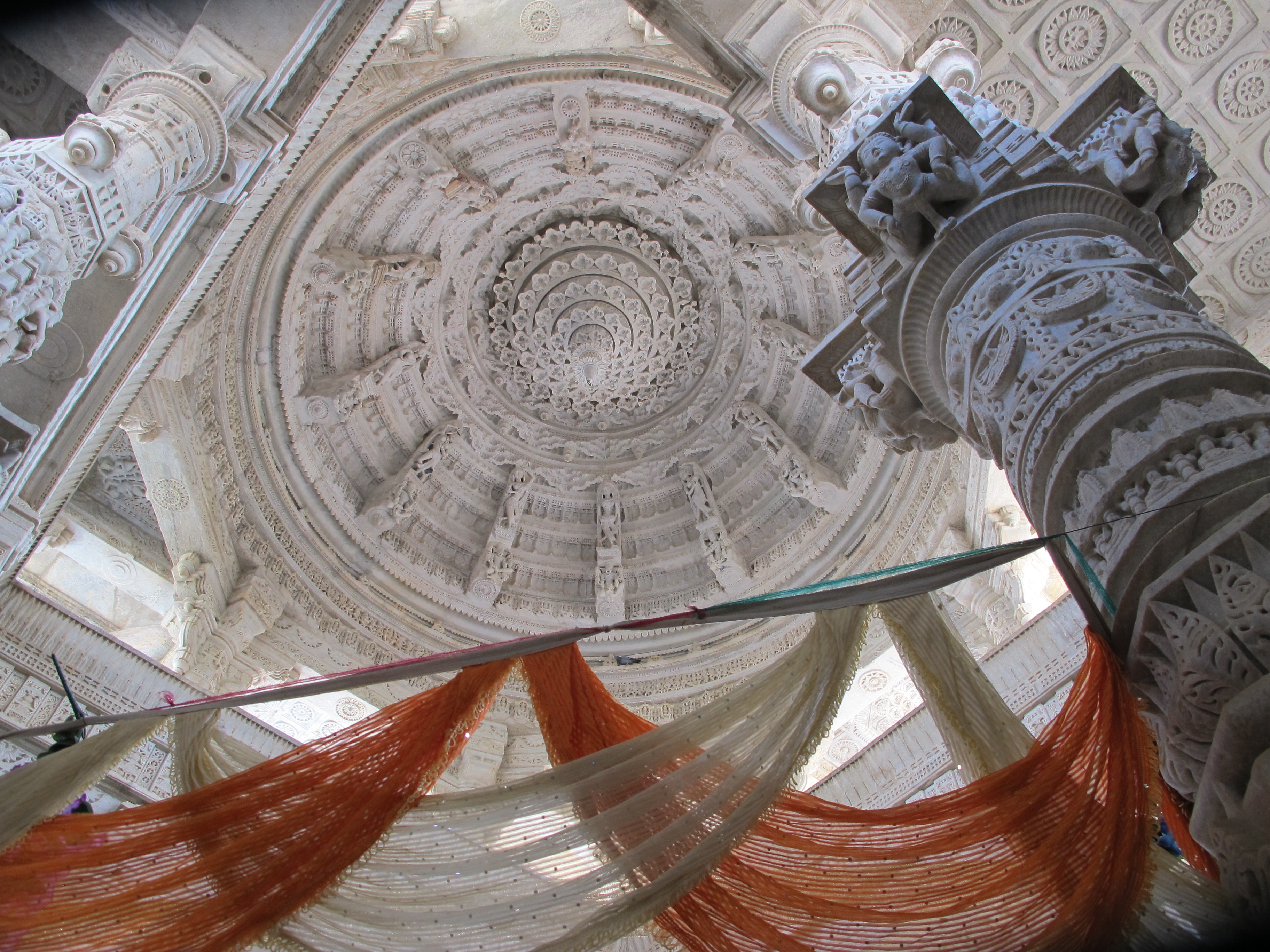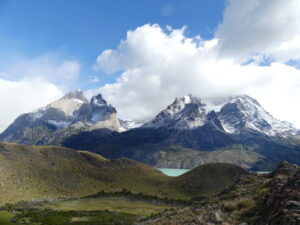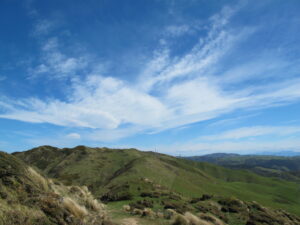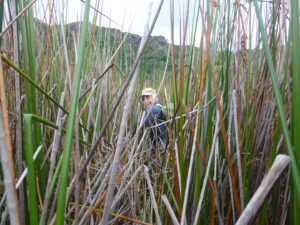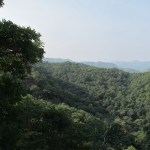
“What are you doing here?” asked the father of three, a software engineer for Microsoft from Pune, Maharashtra.
He was not threatening us or anything like that, but just astonished we were staying at this inn, which comprised a set of cabins that were a hybrid of a tent (top) and stone hut (walls and base), out in the middle of nowhere. Well, not quite nowhere.
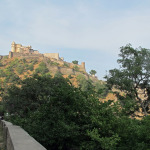
Within a kilometer or so loomed the bare, but haughtily situated Kumbalgarh Fort, one of those built by a Rajput emperor of the Mewar clan in the 15th century. The palace within was drab and unadorned. The access to it was straightforward and not intriguingly complex to confound invaders, as others have been. (It was never sacked, but the Mughals won its attack by poisoning the water supply.)
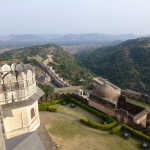
Yet it stood impressively atop a treeless ridge line amid the Aravali Hills after more than a half millenium. From the top you could see a number of imposing temples and shrines down below, and the fortified walls snaking up and down the hills, a bit like the Great Wall of China. They wander for more than 35 kilometers so it can take a few days of hiking just to follow them.
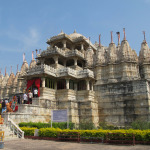
About 15 kilometers west, in Ranakpur, where the hills drop into a wide valley, is an impressive sight of a different sort. It’s a massive, frothy wedding cake of a building, a Jain temple in soft white marble dating from the 15th century and still active as a religious site.
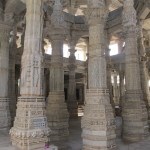
Its a wonder to see, with seemingly endless carved columns, shrines and prayer spaces extending in all directions under intricately sculpted domes, as well as emerald and jade images of the tirthankaras, or helpers to nirvana (click here to read our post on Bahubali).
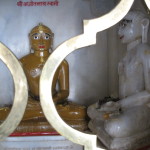
Its central shrine, open only to Hindus and Jains, features a life-sized statue of the first tirthankara, Adinatha. It was crowded with worshippers even as the tourists buzzed about the columns and side-naves.
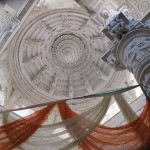
In between these two sites and stretching for kilometers on the way from Jaipur/Jodhpur to Udaipur are the graceful Aravali Hills, lumpy green mounds lapping and overlapping each other. Though the hills are drought-affected now, waterways suddenly pop up in hollows and picturesque streams trickle down the hillsides. The section here is a wildlife sanctuary, home to lots of monkeys, leopards, and other native animals to look for on safari by camel or jeep…or foot.
That’s pretty much it within several hours of driving. Otherwise, you’re in a world of small villages. The ancient elders in pagari, the traditional turbans, and white pants, sitting in shade during the heat of the day or herding goats. The thin, statuesque women, dressed in colorful saris even while doing daily tasks. Many of them have added ornate nose rings to their faces, which they often hide as we pass by, out of custom perhaps or “to protect them from the sun and dust,” as one local told us. Their world is one of a few simple mud or stone huts, fields to work, cattle to shuffle around for grazing or to milk. Even the youngest children will be helping in some way; we saw a girl of maybe five or six maneuvering burly water buffaloes around.
In odd contrast, domestic tourism erupts close by these small villages at those two points of interest, fort and temple. Along the dusty roads, rehabbed and newly created palaces entice visitors to live in them like the Maharanas of old Mewar.
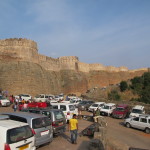
Indians do love to stay here. The area has become particularly popular with Gujaratis. Gujarat is just a short drive south of Udaipur, baking much of the year in the plains. So, to holiday, especially following Diwali, they want to head into the hills for something different – and a bit cooler, less polluted. They’re joined by a good number of Maharashtrans as well, especially from Mumbai. Young marrieds, large extended families, social groups, all herd themselves up here.
Perhaps it’s just being on holiday, but many of these Indian tourists are dressed in western styles, unlike the locals and even urban Rajasthanis. And we found that a Gujarati likes to party. At our quasi-campground, several groups hung out in the evening drinking wine and vodka, though they did pack it in by 11pm.
Meanwhile, foreigners – French, Aussies, British, German these days – just pass through for the most part, stopping by the Jain temple for a lunch break between Jodhpur and Udaipur. Soon they’re heading off to more touristed splendors like Amber Fort or the lakes of Udaipur.
And that’s why the software engineer from Pune was trying to figure out why we were there, the only foreigners at the hotel – or perhaps any hotel in the area.
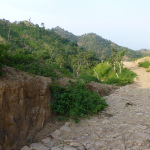
It was for the hiking through that national park, we explained. In our six months of travel, with so much we wanted to see, we hadn’t planned on many long hikes in India. In the most engaging national parks, they insist on driving or boating on guided safaris, not walking…what with the inconvenience of ornery elephants and man-eating tigers lurking about. And then there are those pesky leeches along the trails during the rains (click here to read our post on walking thru Periyar). Elsewhere, most treks are unmarked trails where you can get seriously lost. The guided Himalayan treks were tempting but we didn’t have the equipment, especially with the threat of monsoons coming shortly. There just were not a lot of places to go for a woodsy walk.
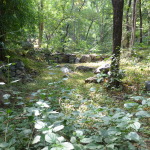
But this trek through a lovely section of nowhere suited us just fine. For about four hours, we followed narrow, rubbly and twisting paths. We retraced what must have been old British carriageways, still largely intact, with their rough cobblestone paving on the steeper sections and stone embankments at the narrow sections. We traipsed through meadows of old forest and dark groves, then alongside dry or still trickling riverways. We followed a ridge line with long tranquil views across other ridges and rolling hills to the valley beyond.
And we were completely alone here.
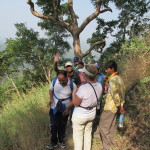
In a country of 1.3 billion and with all those Gujaratis gadding about, we had this patch to ourselves. Well, except for hundreds of monkeys. And except for that garrulous group of 40 Indians from Mumbai along the trail, uniformly outfitted by a local trekking company in baseball caps and t-shirts, gamely huffing up the steep hillside.
(Also, for more pictures from India, CLICK HERE to view the slideshow at the end of the India itinerary page.)


